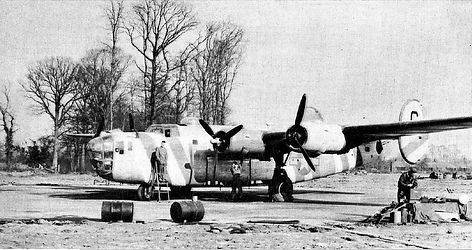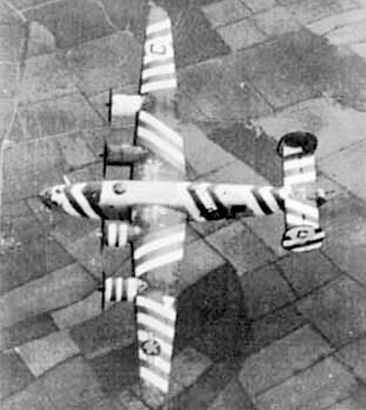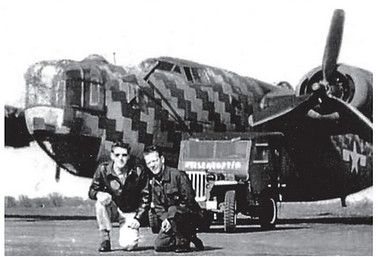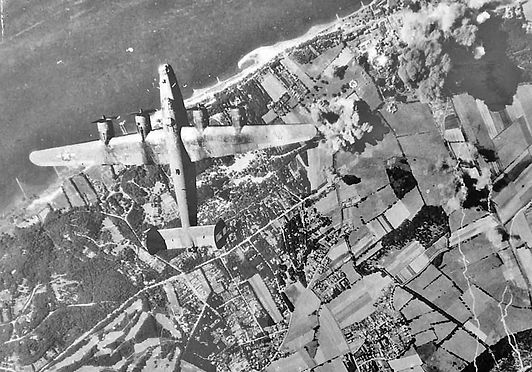Operation Tidal Wave:
The Raid on the Ploesti Oil Refinaries

B24s practicing low-level bombing in the Libyan desert ahead of Operation Tidal Wave (C/OB Andrews Collection, AMM)
On Sunday 1st August 1943, the USAAF suffered its second highest loss in a single operation. It was forever to be known as Black Sunday.
Bombing missions were usually carried out at high level and in daylight, as part of the Combined Bomber Offense which meant 24 hour bombing of German targets. Petroleum production and distribution systems were among their highest priority targets in order to cut off the major life support of Hitler's war machine. 30% of the enemy's fuel came from the oil fields and associated refinaries in and around Ploesti in south east Romania and they were to be the target on 1st August 1943. It was called Operation Tidal Wave.
B24s were unable to reach the target from England and so were to fly the mission from Libya. Three bomb groups of the 8th Air Force from England - the 44th, 93rd, and 389th "Sky Scorpions", flew to Benghazi to meet up with two from North Africa - 98th and 376th from the 9th Air Force, and by July1943 they were were undergoing intense training as a unit. But, instead of the usual high level tactics, this raid was to be very different form what the crews had experienced before. It was to be flown at low level - 200 feet.
Nine refinaries were to be hit simultaneously and the target for the 30 B24's from the 389th was the Campina refinary ("Red Target") which was slightly away from the rest and to the northwest of Ploesti.
At 07.29 on the 1st August, 177 B24 Liberators (one of the 30 from the 389th - The Bad Penny - lived up to her name and suffered mechanical failure on the ground so did not leave) thundered down the sandy runway and set course towards Ploesti. The separate formations would enter southwestern Romania through Southern Yugoslavia, and would approach Ploesti from the east. They would then ultimately commence the aerial strike from the north, hitting the nine Ploesti refineries simultaneously at low altitudes.


389th Bomb Group Formation Plans
However, things did not go to plan. After a rather stressful and disorganised flight, not helped by navigational errors and accidents due to orders for absolute radio silence, the USAAF bomber groups arrived over Romania in scattered formations. The enemy was now fully aware of their presence. Confusion and chaos reigned with bombers flying in to attack their targets only to find them already in flames where bombers ahead of them had mistaken their assigned target as well as being attacked by anti aircraft fire from below.

Planned attack route
Actual executed route
Meanwhile, the 389th had split away from the 44th and 98th and headed northwest to its target at Campina. Several miles short of the correct IP, the group incorrectly made a turn to the right. Disaster appeared imminent as they were set to miss Campina, and head towards Ploesti. The day was saved when Col. Wood flying with Capt. Caldwell quickly recognized the mistake and led the group in a 180-degree turn to resume their course.
Arriving at the target at 15.05 hours and flying in at 205 mph at 200 feet, they began their attack.
Approaching his bombing target at the Steaua Romana refinery complex at Campina, Romania, German flak guns made two direct hits on Command Pilot Lt Lloyd H. "Pete" Hughes' plane 'Ole Kickapoo' from the 564 squadron of the 389th, blowing large holes in his left wing and in one of the two 300 gallon auxillary fuel tanks in his bomb bay. Watching from behind, his close friend, Major Phillip Ardery, was hoping Lt Hughes would climb and discharge his bombs at a higher altitude as ahead of them there was a wall of fire and smoke. But Hughes and his co-pilot Lt Ron Heder, flew their B24 straight into the fire emerging with their left wing and fuselage streaming long sheets of flame. Hughes and Helder stayed with their squadron at low level despite being engulfed in flames and continued onto their target, successfully releasing their bombs and hitting the Steaua Romano refinery. Only after this, did Lt Hughes attempt to pull up to slow his plane to make a crash landing in the dry Prahova River Valley. As Hughes and Helder settled their stricken B24, their right wing spar folded from the intense heat of the plane’s fire and hit the Prahova Valley’s riverbank. The plane cartwheeled and crashed into the ground in a ball of fire. Lt Hughes, his co-pilot, Lt. Helder, and most of the crew died in the crash, minus two gunners, who, somehow, escaped from the burning crash, and survived with terrible burns.
For his bravery, Lt Pete Hughes was awarded the Medal of Honor for his leadership, his skill, bravery, sacrifice, and, determination to carry out his mission with no thought to his own safety. Lt Ron Helder and the rest of the ten member crew all received the nation's second highest honor and award, Distinguished Service Crosses.
Lt Pete Hughes' full citation is below:
For conspicuous gallantry in action and intrepidity at risk of his life above and beyond the call of duty. On 1 August 1943, 2d Lt. Hughes served in the capacity of pilot of a heavy bombardment aircraft participating in a long and hazardous minimum-altitude attack against the Axis oil refineries of Ploesti, Rumania, launched from the northern shores of Africa. Flying in the last formation to attack the target, he arrived in the target area after previous flights had thoroughly alerted the enemy defenses. Approaching the target through intense and accurate antiaircraft fire and dense balloon barrages at dangerously low altitude, his plane received several direct hits from both large and small caliber antiaircraft guns which seriously damaged his aircraft, causing sheets of escaping gasoline to stream from the bomb bay and from the left wing. This damage was inflicted at a time prior to reaching the target when 2d Lt. Hughes could have made a forced landing in any of the grain fields readily available at the time.

Lt Lloyd H. "Pete" Hughes
The target area was blazing with burning oil tanks and damaged refinery installations from which flames leaped high above the bombing level of the formation. With full knowledge of the consequences of entering this blazing inferno when his airplane was profusely leaking gasoline in two separate locations, 2d Lt. Hughes, motivated only by his high conception of duty which called for the destruction of his assigned target at any cost, did not elect to make a forced landing or turn back from the attack. Instead, rather than jeopardize the formation and the success of the attack, he unhesitatingly entered the blazing area and dropped his bomb load with great precision. After successfully bombing the objective, his aircraft emerged from the conflagration with the left wing aflame. Only then did he attempt a forced landing, but because of the advanced stage of the fire enveloping his aircraft the plane crashed and was consumed. By 2d Lt. Hughes' heroic decision to complete his mission regardless of the consequences, in utter disregard of his own life, and by his gallant and valorous execution of this decision, he has rendered a service to our country in the defeat of our enemies which will everlastingly be outstanding in the annals of our nation's history
The next plane to start its attack at 15.10 was Col Wood's lead ship "The Scorpion" piloted by Major Ken Caldwell, quickly followed by the other Sky Scorpions and found most of the fuel storage tanks were already abalze.
With his plane badly crippled, Lt Robert Horton tried to land "Sand Witch" in the same valley as Hughes. Sadly only one crew member survived. All ten received the Distinguished Service Cross.
With all bombs deployed, all the remaining crews had to do now was make it home. However, many of the aircraft were badly scarred from their mission. Captain Robert Mooney's "Hitler's Hearse" was low on fuel and flying on three engines. A single bullet then hit Mooney in the head and killed him instantly. Lt James' B24 'S' was suffering fuel leakage - a recurrent problem with his aircraft - and the two ships decided to join up and to try and make it to neutral Turkey. 'Hitler's Hearse', the pilot seat now taken by T/Sgt Gerrets, and Lt James' 'S' were relieved to find themselves enscorted by two healthy B24s: Lt Bill Nading's 'Blondes Away' and Lt Podolak's 'Sweet Adeline ll'. After escorting James and Gerrits to Turkey, the escorts then continued on to Allied held Cyprus.
But many didn't make it out of Romania. While still just south of Campina, Lt Robert O'Reilly in borrowed ship 'Chatanooga Choo Choo' knew that flying on just two engines, clearing the mountains would be impossible so opted for a crash landing. By sheer good fortune they found themselves on the estate of the
Princess Ecatherina Carajda. The Princess who had a fondness for Americans, nursed the injured crew members and then turned them over to the Romanians who treated them as guests rather than prisioners. Thanks to the Princess, the prisoners were escorted to a POW camp in Timisul de Jos, a former luxury ski resort, which was described by navigator Lt Richard Britt as “probably the best prison camp in the world.”

Lt Richard Britt of Houston, Texas, greets Romanian Princess Ecaterina Caradja during a surprise meeting on the set of the NBC television show 'Today' in December 1955.
Lt Melvin Neef's 'The Boomerang' was another not to make it out of Romania. Half an hour after the raid, flying on just number one and two engines, and unable to feather the props on engines three and four they opted to crash land in a field. There were no fatalties and all eleven crew were captured.
Several others either headed to Malta or Turkey as they were unable to make the distance back to Benghazi.
However, Col Emery Ward radioed he was low on fuel and would have to return direct rather than via the planned route, his wing men Spurrier and Sissons remaining with him in case he needed to ditch into the sea. This was fortunate as they encountered six ME109s who thought better of attacking and flew off. After a flight of thirteen hours and ten minutes, they landed in Benghazi, with Ward's plane running completely out of fuel on the runway. They were the first to return.
Thitreen hours and fifty minutes after take off, the last of the SkyScorpions,'Ole Irish' piloted by Frank McLaughlin, landed in Benghazi. Of the twenty nine B24s of the 389th, only eighteen made it home.
As well as crews flying directly with the 389th, there were six other crews from the 389th that were seconded to fly with the 98th, as well as other crew members tasked with making up the 98th crew numbers. 'Stinger' flown by Lt Opsata, 'Daisy Mae' flown by Lt Lewis Ellis, and 'Battleaxe' flown by Lt Sayler all returned to Benghazi, and 'Chief' flown by Lt Fravega diverted to Sicily. 'The Witch' flown by Lt Darlington and 'Bashful/Jersey Jackass' crash landed. 'Snake Eyes' from the 98th carrying two 389th crew members crash landed in Sicily, but sadly 'Four Eyes' also carrying two from the 389th failed to return.
The 389th's attack on Camina was seen as a success, but at a cost. Nineteen were killed, twenty three taken prisoner and nineteen interned in Turkey. Of those that flew with the 98th, eleven were killed, ten captured, and four escaped to Yugoslavia to join up with Tito's resistance.
The allies thought they would have the element of surprise but that was far from the case. Alerted by Romanian defences and tracked by German radar, the enemy was waiting for them. Defences around Ploesti had been fortified following an earlier failed attack and was now amongst Europe’s most rigid air defense network, plus three fighter groups lay in wait.
Further tragedy struck when the "Jose Carioca" flown by Nicholas Stampolis of the 93rd, crashed into a women's prison in Ploesti killing a hundred inmates.
By the end of the last attack only 88 of the original 177 bombers that took off that morning could still fly and manage to make it back to Benghazi, most them in bad shape and with many injured aboard. Personnel losses were high with 440 confirmed dead, 108 captured, and 78 interned in Turkey.
But the mission as a whole did not achive its full potential. While three of the nine oil fields and refinaries were knocked out, only about 46% of the capacity was incapacitated, and the Germans were quickly able to get the infrastructure back on line.
While Operation Tidal Wave remains one of the USAAF's most valiant raids, they never flew another low level mission again. The losses were far too geat.
The 389th bomb group were awarded Distinguished Unit Citation for their role in the mission.
The crews and aircraft of the 389th bomb group which took part in Operation Tidal Wave

The Formation Assembly Ships of the 389th
During World War 2, hundreds of B24 Liberators, heavy with bombs, were often seen during the day, slowly climbing through the sky from airfields in the east of England to meet with those from other bomb groups. They would be joining other Liberators preparing for a dangerous bombing mission somewhere over Europe, and assembling all the aircraft into one organised mass in tight airspace could be as treacherous as the mission itself. Confusion reigned: bombers would form up with the wrong group, and collisions even in broad daylight were not unheard of. Poor light and visibility often added to the difficult manoeuvre.
When someone had the bright idea of using one striking looking aircraft as a group identifier, the solution seemed obvious. Aircraft which had seen far better days were selected to be a group’s formation assembly plane. These war weary planes, while their fighting days were over, still had their well-deserved moment in history.
All armaments and armour plating were stripped out, they carried minimal fuel and were the first from each group to take off on their way to circle at the designated assembly point. Crew were minimal, consisting only of two pilots, navigator, radio operator and one or two crew to discharge flares which were to be set off in a coded pattern. White flashing navigation lights on both sides of the fuselage took the form of the group’s identification letter.
But what made them so unforgettable (and unmissable) was their spectacular paintwork. Painted as gaudy, bright and outlandish as the imagination could muster, the aim was to be seen from afar. Polka dots, stripes, zig-zags, and sharks heads to name a few – each group had its own distinctive colour scheme and pattern. A group’s bombers were then able to gently and gradually, form up behind them. It must have been a spectacular sight to see so many brightly painted aircraft leading their prodigy. Once all the groups had lined up behind their assembly plane at the assembly point, the assembly plane would gently climb and turn to return to the group’s base, leaving its olive-drab colleagues to their fate as they carried on to the target.
While at Hethel, “Green Dragon” served in several other roles as well as assembly, including weather missions and the occasional photo shoot. Her livery was a striking wrap-around of four green-yellow-green-yellow diagonal stripe groupings. Her inner engine cowlings were initially painted green and the outer yellow, but in the spring of 1944, her cowlings were circled with green and yellow stripes. She was heavily damaged in a taxiing accident at RAF Manston on 26th July 1944 and scrapped.
Her livery, however, was a much simpler design compared to what came next.

The first formation assembly plane used by the 389th bomb group based at Hethel, Norfolk, was an early B24D serial number 41-23683 previously named “Jo-Jo’s Special Delivery” which had served with the 93rd bomb group. She was declared ‘war weary’ and transferred in September 1943 to the 389th to serve as their formation assembly ship. She was renamed “The Green Dragon” as homage to an historic local pub in nearby Wymondham frequented by air crews, called the Green Dragon. It is still there.

“Green Dragon 2” was a later B24J serial number 42-99972. Previously called “Sad Sack” after a cartoon character, she wore a dazzling livery of interlinked small green and yellow squares, painted such that they appeared in zig-zags on the fuselage. It was not an easy paint job! By the spring of 1945, a shark’s mouth and eye had been added to her nose. She survived the war and flew back to the States only to be later scrapped.


Although not directly an assembly ship for the 389th, it’s worth mentioning B24D-40722, “The Little Gramper” which took part in the low level bombing raids with the 389th on the Ploesti oil refinaries on 1st August 1943. In her lifetime, she completed a total of 49 missions, at least 25 of them with the 389th. In 1944 she was transferred to the 491st as their first assembly aircraft. She had a very distinctive yellow polka dot livery. Sadly, she was very war weary, failing an inspection four months later and scrapped.

The Run Up To D-Day

From March until May of 1944, the 389th Bomb Group concentrated their bombing efforts on a number of key specified targets. These included German aircraft production plants and fighter airfields to reduce fighter opposition, railroad marshalling yards and supply routes to hinder the movement of German troops and armoury, and synthetic oil refineries in order to cut the production of fuels for use in aircraft, tanks and army trucks.
The aim of these attacks was to reduce the strength of the German forces before the invasion took place. This would hopefully make the allied forces' job easier, and help to reduce casualties. The bombing of the V1 rocket launch sites was to stop the bombs striking London, and related civillian casualties.
Pictured above and right:
B-24s above a German oil refinery and an aircraft production plant.
